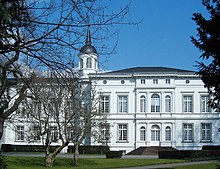11th G7 summit: Difference between revisions
→External links: + G8 summits navbox |
Lucy-marie (talk | contribs) |
||
| Line 21: | Line 21: | ||
* {{flagicon|United Kingdom}} '''[[United Kingdom]]''' - [[Prime Minister of the United Kingdom|Prime Minister]] [[Margaret Thatcher]].<ref name="j-mofa1"/> |
* {{flagicon|United Kingdom}} '''[[United Kingdom]]''' - [[Prime Minister of the United Kingdom|Prime Minister]] [[Margaret Thatcher]].<ref name="j-mofa1"/> |
||
* {{flagicon|USA}} '''[[United States]]''' - [[President of the United States|President]] [[Ronald Reagan]].<ref name="j-mofa1"/> |
* {{flagicon|USA}} '''[[United States]]''' - [[President of the United States|President]] [[Ronald Reagan]].<ref name="j-mofa1"/> |
||
+ |
|||
* {{flagicon|EU}} '''[[European Communities]]''' - [[President of the European Commission|President]] [[Jacques Delors]]<ref name="ec1">{{cite web| url = http://www.deljpn.ec.europa.eu/union/showpage_en_union.external.g8.php| title = EU and the G8| accessdate = 2007-09-25| publisher = European Commission}}</ref> |
|||
==Issues== |
==Issues== |
||
Revision as of 21:34, 10 April 2009
| 11th G7 summit | |
|---|---|
 Schaumburg Palace in Bonn | |
| Host country | Germany |
| Dates | May 2-4 |
The 11th G7 Summit was held in Bonn, West Germany between May 2 and May 4 in 1985. The venue for the summit meeting was at the former official residence of the Chancellor of the Federal Republic of Germany in Bonn, the Palais Schaumburg.[1]
The Group of Seven (G7) was an unofficial forum which brought together the heads of the richest industrialized countries: France, Germany, Italy, Japan, the United Kingdom, the United States, Canada (since 1976)[2] and the President of the European Commission (starting officially in 1981).[3] The summits were not meant to be linked formally with wider international institutions; and in fact, a mild rebellion against the stiff formality of other international meetings was a part of the genesis of cooperation between France's President Giscard d'Estaing and Germany's Chancellor Helmut Schmidt as they conceived the first Group of Six (G6) summit in 1975.[4]
Leaders at the Summit
The composition of the G7 summit is a perennial topic. The G7 summits after 1981 considered the President of the European Commission as a permanently welcome participant in all meetings and decision-making, which means that this G7 summit has eight essential participants.[3]
 Canada - Prime Minister Brian Mulroney.[1]
Canada - Prime Minister Brian Mulroney.[1] France - President François Mitterrand.[1]
France - President François Mitterrand.[1] West Germany - Chancellor Helmut Kohl.[1]
West Germany - Chancellor Helmut Kohl.[1] Italy - Prime Minister Bettino Craxi.[1]
Italy - Prime Minister Bettino Craxi.[1] Japan - Prime Minister Yasuhiro Nakasone.[1]
Japan - Prime Minister Yasuhiro Nakasone.[1] United Kingdom - Prime Minister Margaret Thatcher.[1]
United Kingdom - Prime Minister Margaret Thatcher.[1] United States - President Ronald Reagan.[1]
United States - President Ronald Reagan.[1]
Issues
The summit was intended as a venue for resolving differences among its members. As a practical matter, the summit was also conceived as an opportunity for its members to give each other mutual encouragement in the face of difficult economic decisions.[4] Issues which were discussed at this summit included:
- Growth and Employment
- Relations with Developing Countries
- Multilateral Trading System and International Monetary System
- Environment Policies
- Cooperation in Science and Technology
See also
Notes
- ^ a b c d e f g h Japan, Ministry of Foreign Affairs (MOFA): Summit Meetings in the Past.
- ^ Saunders, Doug. "Weight of the world too heavy for G8 shoulders," Globe and Mail (Toronto). July 5, 2008 -- n.b., the G7 becomes the Group of Eight (G7) with the inclusion of Russia starting in 1997.
- ^ a b Reuters: "Factbox: The Group of Eight: what is it?", July 3, 2008.
- ^ a b Reinalda, Bob and Bertjan Verbeek. (1998). Autonomous Policy Making by International Organizations, p. 205.
References
- Bayne, Nicholas and Robert D. Putnam. (2000). Hanging in There: The G7 and G8 Summit in Maturity and Renewal. Aldershot, Hampshire, England: Ashgate Publishing. 10-ISBN 0-754-61185-X; 13-ISBN 978-0-754-61185-1; OCLC 43186692
- Reinalda, Bob and Bertjan Verbeek. (1998). Autonomous Policy Making by International Organizations. London: Routledge. 10-ISBN 0-415-16486-9; 13-ISBN 978-0-415-16486-3
External links
- No official website is created for any G7 summit prior to 1995 -- see the 21st G7 summit.
- University of Toronto: G8 Research Group, G8 Information Centre
